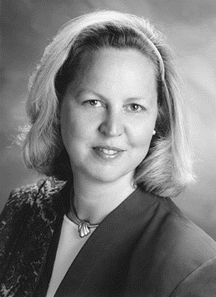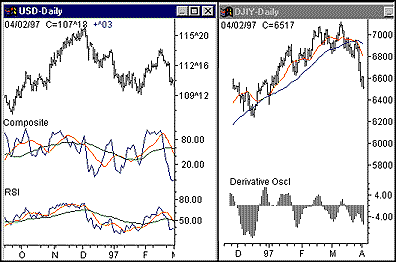INTERVIEW
On The Aerodynamic Trader
Constance Brown
by Thom Hartle
"Aerodynamic" may seem like a peculiar description for a trader, considering what the word brings to mind at first glance: smooth and sleek, streamlined to minimize resistance. And yet, think about it. Successful traders are mentally streamlined. Winning traders display minimal emotional resistance to a high-risk environment, only trusting their skills to trade. This focused mental state is comparable to those of top athletes who go into head-to-head competition concentrating on their goal, free of any excess mental baggage that could weaken their performance; they operate with a mental toughness to bring home the gold. One trader knows both challenges: Connie Brown, who was at one time a world-class swimmer, and who is today a professional trader as well as the author of the work Aerodynamic Trading. STOCKS & COMMODITIES Editor Thom Hartle interviewed Brown via telephone on March 24, 1997, about trading, the similarities to athletic competition and other topics.
 When you're first starting out, you try to learn as much as you can. The more you learn, the more tempting it is to become more complex and try to incorporate all these methods you've been studying into one approach. That's the first phase.
-- Connie Brown
When you're first starting out, you try to learn as much as you can. The more you learn, the more tempting it is to become more complex and try to incorporate all these methods you've been studying into one approach. That's the first phase.
-- Connie Brown
So did you come right out of school and jump into trading?
No. My business career began with Eastman Kodak. I was first hired as a sales representative and had various positions throughout my 11 years there. By the time I finally resigned from Kodak, I was a brand manager with responsibilities for Kodak's professional color films. That was back in the days when the Hunt brothers had such an impact on the silver market.
So you were aware of the Hunt brothers and the silver market before you actually got into the market?
Definitely! Silver is a major cost factor in manufacturing film, so I became very interested in the futures markets. Of course, I didn't know very much about the markets, but I started asking a lot of questions, and my interest grew into a passion. Soon, I found I was working on my charts most of the night and on the marketing plans by day. Something had to go. I was still very young at the time, and the prospect of living in Rochester, NY, for the rest of my working days, well --
Your career options weren't quite as diversified in upstate New York as they might have been if you had been living elsewhere, I would imagine.
No. So I decided to start a new career and pursue these new interests.
So you ultimately left Kodak for Wall Street?
Yes. I jumped at the first opportunity, and that placed me inside a bond department. Before I was hired, I had barely heard of junk bonds -- excuse me, high-yield bonds.
In that case, what led you to the bond department?
Actually, I was interviewed for the job without my even being aware of it.
The firm I joined used fundamental research. In fact, I was told that if I ever brought a chart into the trading room, I would be instantly fired.
You probably looked at a lot of different aspects of technical analysis. What approaches did you settle on?
I've evolved into using three non-correlated methods: momentum, Gann, and the Elliott wave principle.
How did that come about?
It's really a cycle. When you're first starting out and you don't really know a lot about technical analysis, you try to get your hands on everything possible to learn as much as you can. Sometimes a method will work for you, sometimes it won't. The more you learn, the more tempting it is to become more complex and try to incorporate all these different methods you've been studying into one single approach. That's the first phase.
What's the next phase?
The next phase is when you begin to realize that there are similarities among indicators. Then you study which indicators provide the strongest signals to you and which methods don't have a high correlation to one other. That's the point you realize you want to remove the redundant indicators and work on the weaknesses of those you keep.
And finally?
Finally, it evolves to the point that you come back to something that may be simpler, but by then you'll have a tremendous understanding of the indicators that you've studied and that you can now use effectively.
So the goal is to really narrow your focus?
Yes.
You mentioned you use momentum. Could you elaborate on that?
Sure. I use indicators on indicators. For example, it's very common for traders to use stochastics and the relative strength indicator (RSI), but I use indicators on those indicators so I can improve the timing and be able to see market turns before the masses actually see it through more typical methods.

Figure 1: The composite index and derivative oscillator. Brown uses the derivative oscillator with an indicator called the composite index. The composite index is an indicator on the relative strength indicator, which shows signals before the RSI itself has revealed a market signal.
So what would be an example of an indicator on an indicator?
Hm. I'm not intentionally holding back, but the formulas, techniques and rules are just too complex to cover here. The MTA Journal published an article of mine called "The derivative oscillator," and it's nearly 20 pages long. I really don't want to give your readers a simplified version, because it would be misleading.
In that case, can you just tell me about the derivative oscillator?
Sure. I use the oscillator with an indicator I developed called the composite index (Figure 1). The composite index is an indicator on the relative strength indicator (RSI), and it shows signals before the RSI itself has revealed a market signal.
Brown, Constance [1995]. Aerodynamic Trading, New Classics Library. This volume can be purchased through Brown's Web site at: https://www.aeroinvest.com. E-mail address: Cbspz@ibm.net or fax: 770 536-1337.
To purchase a copy of Brown's article from The MTA Journal, fax, do not call:
Market Technicians Association, Inc., 1 World Trade Center, #4447, New York, NY 10048
fax: 212 912-1064. "The derivative oscillator" is available for $10.00. The MTA accepts Visa/Mastercard only.
Excerpted from an article originally published in the June 1997 issue of Technical Analysis of STOCKS & COMMODITIES magazine. All rights reserved.
© Copyright 1997, Technical Analysis, Inc.
Return to June Contents



